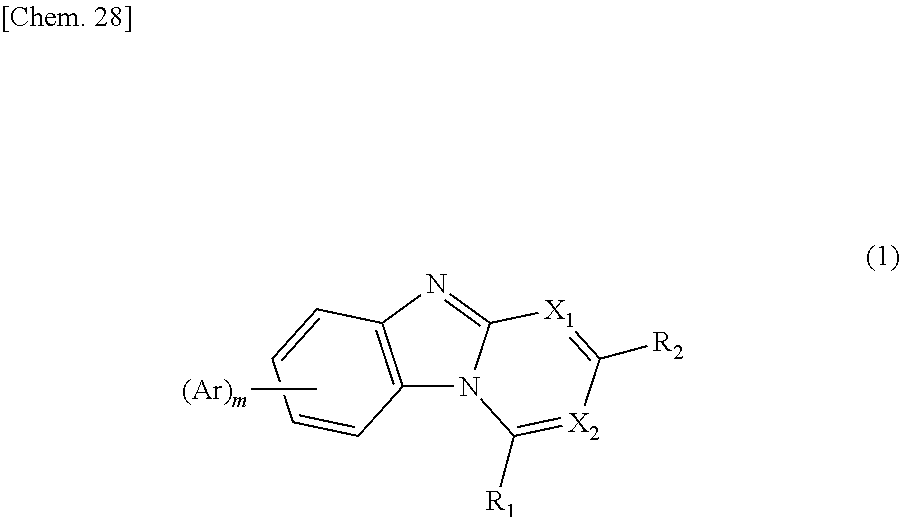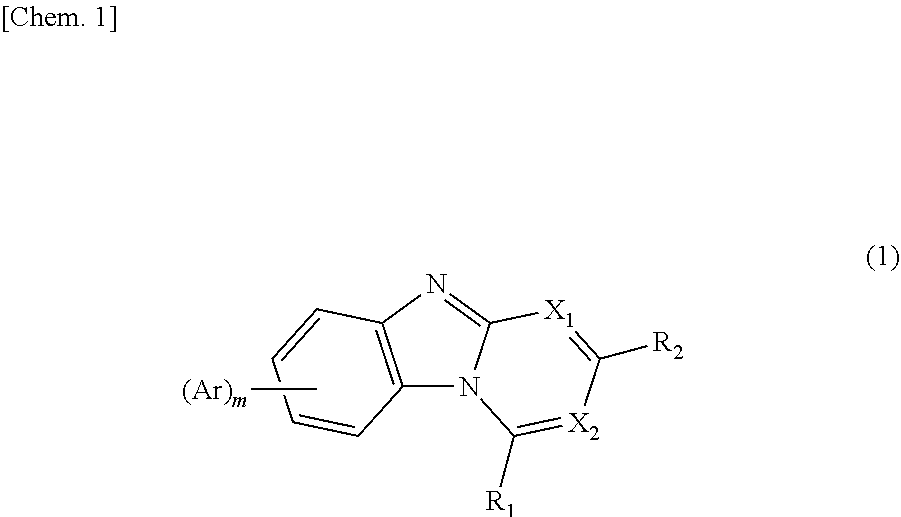Compound including benzimidazole ring structure and organic electroluminescent element
a benzimidazole ring and organic technology, applied in the field of compound including benzimidazole ring structure and organic electroluminescent element, can solve the problems of insufficient hole-blocking property, material degradation, device degradation, etc., and achieve excellent electron injection and transport performance, stable and durable thin film, and low drive voltage.
- Summary
- Abstract
- Description
- Claims
- Application Information
AI Technical Summary
Benefits of technology
Problems solved by technology
Method used
Image
Examples
example 1
Synthesis of 6,8-bis{4-(pyridyl-3-yl) phenyl}-benzo[4,5]imidazo[1,2-a]pyridine (Compound-30)
[0106]In a reaction vessel were put 2,4,6-tribromoaniline: 10.0 g, 2-bromopyridine: 9.6 g, potassium carbonate: 12.6 g, copper powder: 0.2 g, and xylene: 100 mL, followed by stirring under heated reflux for 24 hours. After stirring, the mixture was allowed to stand to cool, then filtered and concentrated to obtain a crude product. Purification of the crude product was performed by using column chromatography (carrier: silica gel, eluent: dichloromethane / ethyl acetate), to thereby obtain brown powder of 6,8-dibromo-benzo[4,5]imidazo[1,2-a]pyridine: 5.9 g (yield 60%).
[0107]A structure of the obtained brown powder was identified with NMR.
[0108]The following 6 hydrogen signals were detected with 1H-NMR (DMSO-d6). δ (ppm)=9.11 (1H), 8.72 (1H), 7.92 (1H), 7.77 (1H), 7.67 (1H), 7.11 (1H).
[0109]Sequentially, thereto were put 6,8-dibromo-benzo[4,5]imidazo[1,2-a]pyridine: 5.0 g, 4-(pyridyl-3-yl) phenyl...
example 2
Synthesis of 6,8-bis{4-(naphthalene-1-yl-phenyl)}-benzo[4,5]imidazo[1,2-a]pyridine (Compound-21)
[0112]In a reaction vessel were put 6,8-dibromo-benzo[4,5]imidazo[1,2-a]pyridine: 5.0 g, 4-(naphthalen-1-yl) phenyl boronic acid: 8.4 g, toluene: 50 mL, and ethanol: 10 mL, then thereto was further added an aqueous solution where potassium carbonate: 6.4 g was dissolved in H2O: 20 mL in advance, and nitrogen gas was aerated while the solution was irradiated with ultrasonic waves for 30 minutes. To the solution where nitrogen gas was aerated was added tetrakistriphenyl phosphine palladium: 0.5 g, followed by stirring under heated reflux for 24 hours. After stirring, the solution was allowed to stand to cool, H2O was added to perform extraction and liquid separation operation, and a collected organic layer was concentrated to obtain a crude product. Purification of the obtained crude product was performed by using column chromatography (carrier: silica gel, eluent: toluene / ethyl acetate), t...
example 3
Synthesis of 8-(9,9-diphenyl-9H-fluoren-2-yl)-6-(4-pyridin-3-yl-phenyl)-benzo[4,5]imidazo[1,2-a]pyridine (Compound-56)
[0115]In a reaction vessel were put 8-chloro-6-(4-pyridin-3-yl-phenyl)-benzo[4,5]imidazo[1,2-a]pyridine: 4.5 g, 2-(9,9-diphenyl-9H-fluorene)-boronic acid: 5.5 g, and 1,4-dioxane: 80 mL, then thereto was further added an aqueous solution where tripotassium phosphate: 8.1 g was dissolved in H2O: 20 mL in advance, and nitrogen gas was aerated while the solution was irradiated with ultrasonic waves for 30 minutes. To the solution where nitrogen gas was aerated were added tris(dibenzylideneacetone) dipalladium (0): 0.3 g and tricyclohexyl phosphine: 0.4 g, followed by stirring under heated reflux for 24 hours. After stirring, the solution was allowed to stand to cool, and a solid precipitated by adding methanol was collected to obtain a crude product. Recrystallization purification of the crude product with a 1,2-dichloro benzene solvent was performed, to thereby obtain y...
PUM
| Property | Measurement | Unit |
|---|---|---|
| voltage | aaaaa | aaaaa |
| luminance | aaaaa | aaaaa |
| external quantum efficiency | aaaaa | aaaaa |
Abstract
Description
Claims
Application Information
 Login to View More
Login to View More - R&D
- Intellectual Property
- Life Sciences
- Materials
- Tech Scout
- Unparalleled Data Quality
- Higher Quality Content
- 60% Fewer Hallucinations
Browse by: Latest US Patents, China's latest patents, Technical Efficacy Thesaurus, Application Domain, Technology Topic, Popular Technical Reports.
© 2025 PatSnap. All rights reserved.Legal|Privacy policy|Modern Slavery Act Transparency Statement|Sitemap|About US| Contact US: help@patsnap.com



